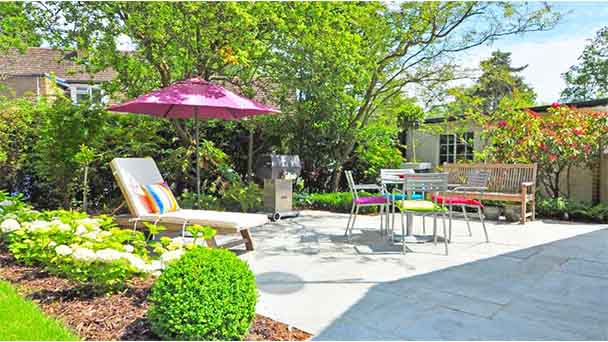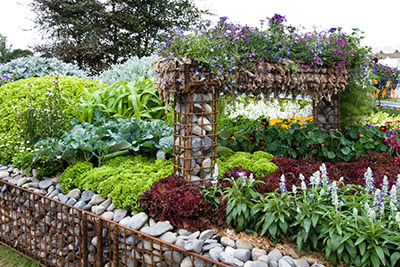How to build a small garden
Written by Joy
Sep 29 2020

How to build a small garden? Do you yearn for fresh vegetables on your plate every night? No matter how big your yard is, you can plan and build a small garden to suit your needs.
The vegetable garden can grow peppers, tomatoes, cabbage, lettuce, potatoes, pumpkin, carrots, and many other vegetables. If a vegetable is suitable for growing in your area, you can find a way to grow it in your small garden.
To grow a small garden, you can plant different types of flowers, so that your garden has flowers open almost all year. Some gardens are precisely planned, while the flowers are planted in neatly arranged pots, while others look more extensive. Your personal style and garden type will determine what types of flowers you might grow.
Some plants cannot grow in certain areas. If you live in a place with mild and humid winters and hot summers, you may be in trouble if you grow plants that require cold currents to function normally.
Unless you plan to make your garden larger, you ought to try to choose plants that require similar growing conditions. Do they need the same soil type and sunshine? If not, you may want to create a garden with several types of growing conditions, but this is too complicated for a small garden you grow.
No matter what type of garden you grow, most plants grow better in rich, well-drained soil. So when choosing a site, you'd better avoid choosing a place in your yard where the water will not flow until after a heavy rain. This may indicate that the soil is too wet or not suitable for healthy plants.
Most vegetables will grow better with plenty of sunlight, so if you want to open a small vegetable garden, choosing a place that is not shaded by trees or your house is necessary. When planting flowers, the choices are more diverse. If you want to put flower pots near the house, you can choose partial or full shade, so that the flowers can grow best.
If your soil is not of high quality, you can grow flowers and vegetables there. The nursery bed is a wooden frame built on the ground, filled with soil, which is the basis for planting plants.
Whether it is planting or after it matures, you should consider the space required by each plant. Make sure that all the plants you want to grow will blend into your garden and have enough space to grow.
If you want a small vegetable garden, you should make sure to make it easy to get in and out of the vegetable garden when designing, and harvest vegetables when they are ripe. For this purpose, you may need a path through the vegetable garden.
The growth of your plants depends on the quality of the soil. You can buy a soil testing tool to find out the amount of organic soil, the amount of nutrients, and the pH of the soil. The test results determine how much fertilizer and other ingredients to add when you build a small garden.
Certain types of compost or mulch are not suitable for certain plants. Behavioural research on planting procedures to ensure that you are properly covering with ground. A soil layer that is too thick may inhibit growth, so make sure that the soil layer you add is suitable for each type of plant.
Once the plants have sprouted, you could water them in the morning instead of at night. Water can stay on the leaves and stems overnight and cause mold and other plant diseases when growing your small garden.
Plan your garden
What role do you want your small garden to play? Some small gardens are functional and plant fruits and vegetables that can be used to feed family members or give away neighbors. Other gardens are for decoration purposes to beautify your home and provide a pleasant sight for people passing by.The vegetable garden can grow peppers, tomatoes, cabbage, lettuce, potatoes, pumpkin, carrots, and many other vegetables. If a vegetable is suitable for growing in your area, you can find a way to grow it in your small garden.
To grow a small garden, you can plant different types of flowers, so that your garden has flowers open almost all year. Some gardens are precisely planned, while the flowers are planted in neatly arranged pots, while others look more extensive. Your personal style and garden type will determine what types of flowers you might grow.
Decide what plants to plant in your garden.
You can use the query to find the plants that are suitable for growing in your small garden. First you'd better determine your area and then see which plants are suitable for growth. When you find more options, please list the plants you want to buy.Some plants cannot grow in certain areas. If you live in a place with mild and humid winters and hot summers, you may be in trouble if you grow plants that require cold currents to function normally.

Unless you plan to make your garden larger, you ought to try to choose plants that require similar growing conditions. Do they need the same soil type and sunshine? If not, you may want to create a garden with several types of growing conditions, but this is too complicated for a small garden you grow.
Choose an address for your garden
You'd better look at your yard and evaluate where you want the small garden to be located. The location you choose should not only help the garden achieve the desired effect, but also help the plants grow strong and healthy.No matter what type of garden you grow, most plants grow better in rich, well-drained soil. So when choosing a site, you'd better avoid choosing a place in your yard where the water will not flow until after a heavy rain. This may indicate that the soil is too wet or not suitable for healthy plants.
Most vegetables will grow better with plenty of sunlight, so if you want to open a small vegetable garden, choosing a place that is not shaded by trees or your house is necessary. When planting flowers, the choices are more diverse. If you want to put flower pots near the house, you can choose partial or full shade, so that the flowers can grow best.
If your soil is not of high quality, you can grow flowers and vegetables there. The nursery bed is a wooden frame built on the ground, filled with soil, which is the basis for planting plants.
Make a garden design
You'd better plan what kind of plant you want first, and the location of each plant is up to you. The customized design is adapted to the needs of plants, ensuring that those plants that need green shade will be planted in the green shade, and those plants that need sufficient sunlight will not be submerged in shade during the day.Whether it is planting or after it matures, you should consider the space required by each plant. Make sure that all the plants you want to grow will blend into your garden and have enough space to grow.
If you want a small vegetable garden, you should make sure to make it easy to get in and out of the vegetable garden when designing, and harvest vegetables when they are ripe. For this purpose, you may need a path through the vegetable garden.
Prepare the soil
You able to use a soil pry or rake to break the soil and outline the boundaries of your garden. You'd better excavate the soil to a depth of about 30 cm to ensure that the soil is soft and there are no large clumps of soil. Remove rocks, rhizomes, and other hard objects from the soil bed in the garden, then fertilize them to prepare for planting.The growth of your plants depends on the quality of the soil. You can buy a soil testing tool to find out the amount of organic soil, the amount of nutrients, and the pH of the soil. The test results determine how much fertilizer and other ingredients to add when you build a small garden.
Plant a garden
You can plant seeds or seedlings according to your design. You'd better dig holes with a shovel a few inches apart, or according to the instructions on the seed or seedling package you buy. It's a good choice to cover the hole between the seed or plant and the soil, and then pat the soil gently.Adding compost, mulch or topsoil is necessary
Certain types of plants require a thin layer of compost, mulch, or topsoil to protect them during seed germination, when plants are often very fragile. You should spread the material over a larger area by hand, or use a soil spreader.Certain types of compost or mulch are not suitable for certain plants. Behavioural research on planting procedures to ensure that you are properly covering with ground. A soil layer that is too thick may inhibit growth, so make sure that the soil layer you add is suitable for each type of plant.
Water the garden
When you have finished planting and processing the soil, you'd better use the fog button of the rubber hose to water the garden thoroughly. You should continue to irrigate the garden every day and increase or decrease the amount of water in different areas according to the needs of the plants. Over-saturation of water in the soil can flood seeds and inhibit plant growth. You'd better not just pour the places where the water comes out. Watering once a day should be sufficient, but watering more than once is good for keeping the garden moist.Once the plants have sprouted, you could water them in the morning instead of at night. Water can stay on the leaves and stems overnight and cause mold and other plant diseases when growing your small garden.
Weed the garden
The clumping weeds draw nourishment from the soil, leaving very little nourishment for your vegetables or flowers. You should weed the garden every few days to make sure your plants get the nutrients they need, and you'd better be careful not to pull out plant seedlings.Latest Updated
- Benefits of Bugleweed - 7 Science-backed Health Benefits
- Bugleweed Dangers & Side Effects - Is It Poisonous?
- How to Plant Evergreen Trees - What You Should Know
- When to Plant Evergreens - Grow Guide for Evergreen Trees
- 12 Wonderful Evergreen Shrubs for Your Garden
- 12 Popular Evergreen Plants with Pictures for Beginners
- When And How To Prune A Lilac Bush Like a Pro
- How to Grow & Care for Lilac Vine (Hardenbergia Violacea)
- Japanese Lilac Tree (Syringa Reticulata) Care & Propagation Guide
- Shumard Oak Pros and Cons - What to Know
Popular Articles
- Winter maintenance of Antirrhinum Majus
- How to Grow Terminalia Mantaly Tree
- How to Grow and Care for Crossostephium Chinense
- How to grow Antirrhinum Majus in spring
- Peristeria Elata (Dove Orchid) Profile: Info & Care Guide
- Underwatered Snake Plant (Sansevieria Trifasciata) - Signs And How To Fix
- How to Care for Brazilian Jasmine Plant (Mandevilla Sanderi)
- How to Grow & Care for Graptopetalum Purple Delight in Summer
- Rosa Chinensis (China Rose): Plant Growing & Care Tips
- How to Care for Baby Sun Rose (Aptenia Cordifolia)